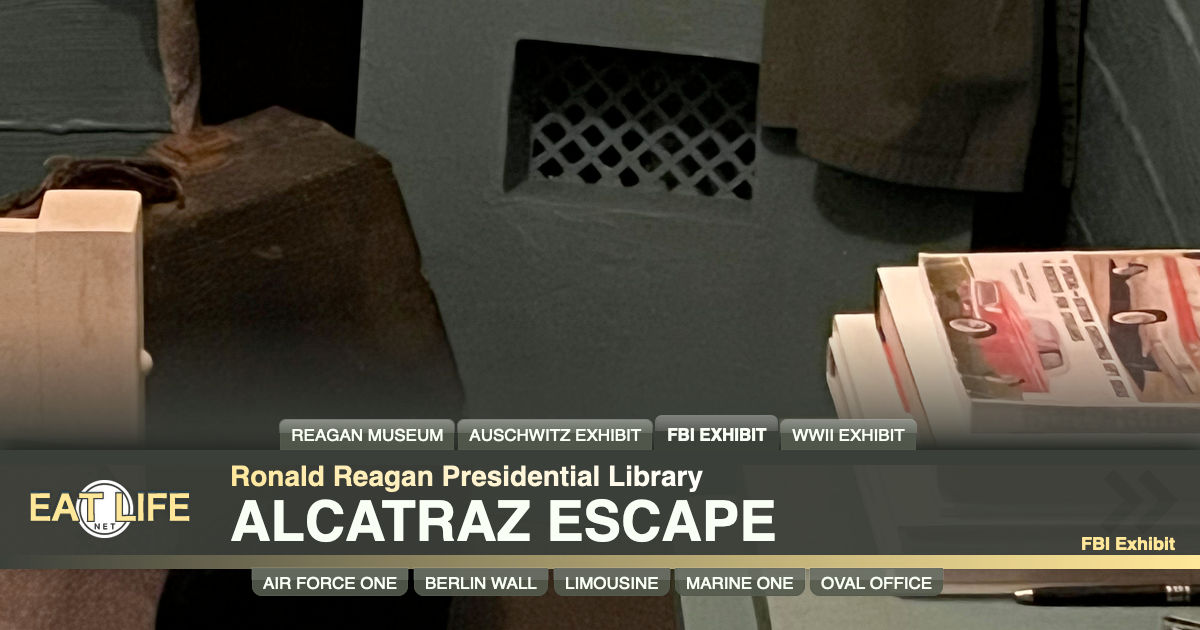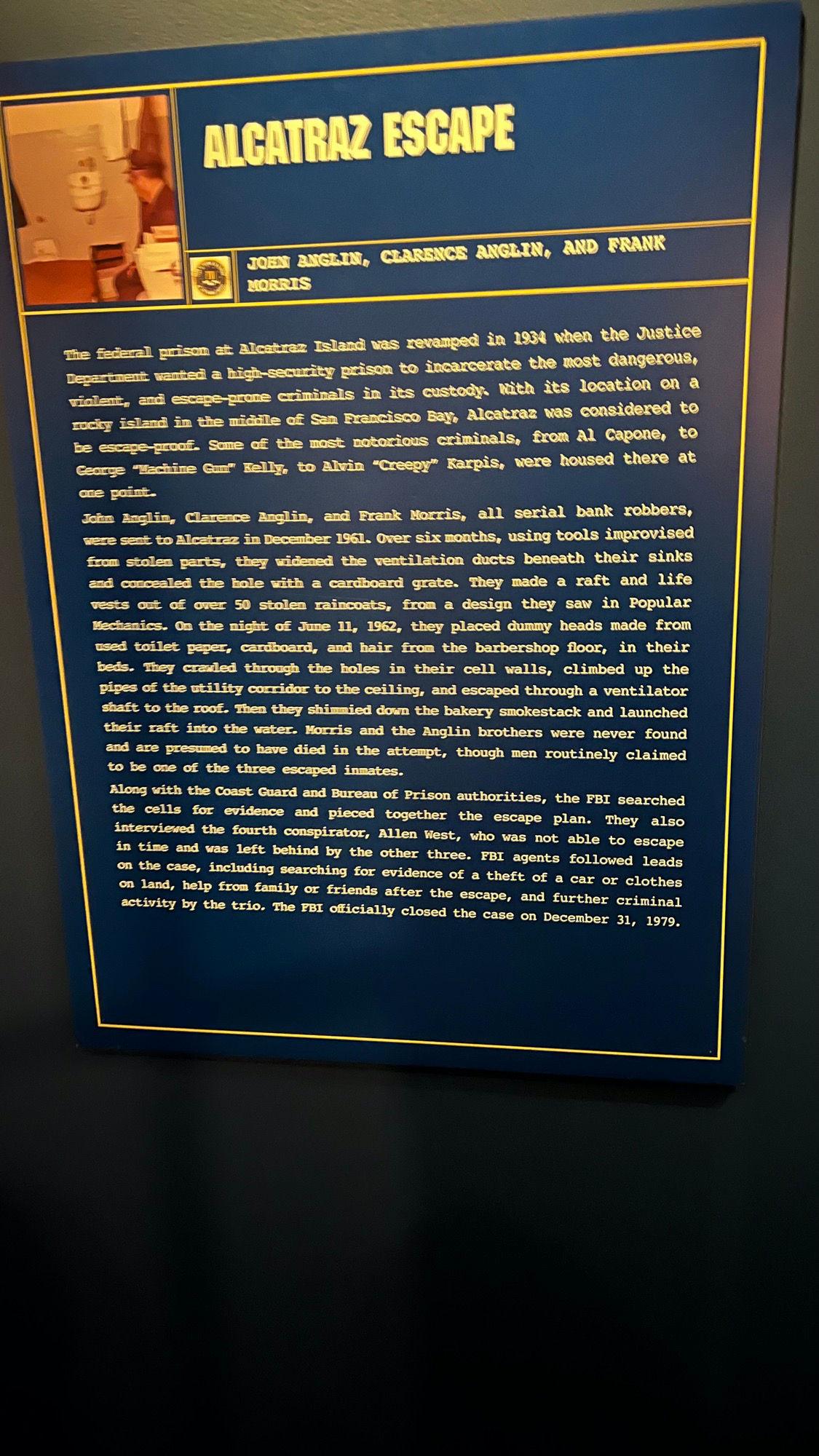
John Anglin, Clarence Anglin, and Frank Morris
The federal prison at Alcatraz Island was revamped in 1931 when the Justice department wanted a high-security prison to incarcerate the most dangerous, violent, and escape prone criminals in its custody. With its location on a rocky island in the middle of San Francisco Bay, Alcatraz was considered to be escape-proof. Some of the most notorious criminals, from Al Capone, to George "Machine Gun" Kelly, to Alvin "Creepy" Karpis, were housed there at one point.
John Anglin, Clarence Anglin, and Frank Morris, all serial bank robbers, were sent to Alcatraz in December 1961. Over six months, using tools improvised from stolen parts, they widened the ventilation ducts beneath their sinks and concealed the hole with a cardboard grate. They made a raft and life vests out of over 50 stolen raincoats, from a design they saw in Popular Mechanics. On the night of Jume 11, 1962, they placed dummy heads made from used toilet paper, cardboard, and hair from the barbershop floor, in their beds. They crawled through the holes in their cell walls, climbed up the pipes of the utility corridor to the ceiling, and escaped through a ventilator shaft to the roof. Then they shimmied down the bakery smokestack and launched their raft into the water. Morris and the Anglin brothers were never found and are presumed to have died in the attempt, though men routinely claimed to be one of the three escaped inmates.
Along with the Coast Guard and Bureau of Prison authorities, the FBI searched the cells for evidence and pieced together the escape plan. They also interviewed the fourth conspirator, Allen West, who was not able to escape in time and was left behind by the other three. FBI agents followed leads on the case, including searching for evidence of a theft of a car or clothes on land, help from family or friends after the escape, and further criminal activity by the trio. The FBI oficially closed the case on December 31, 1979.
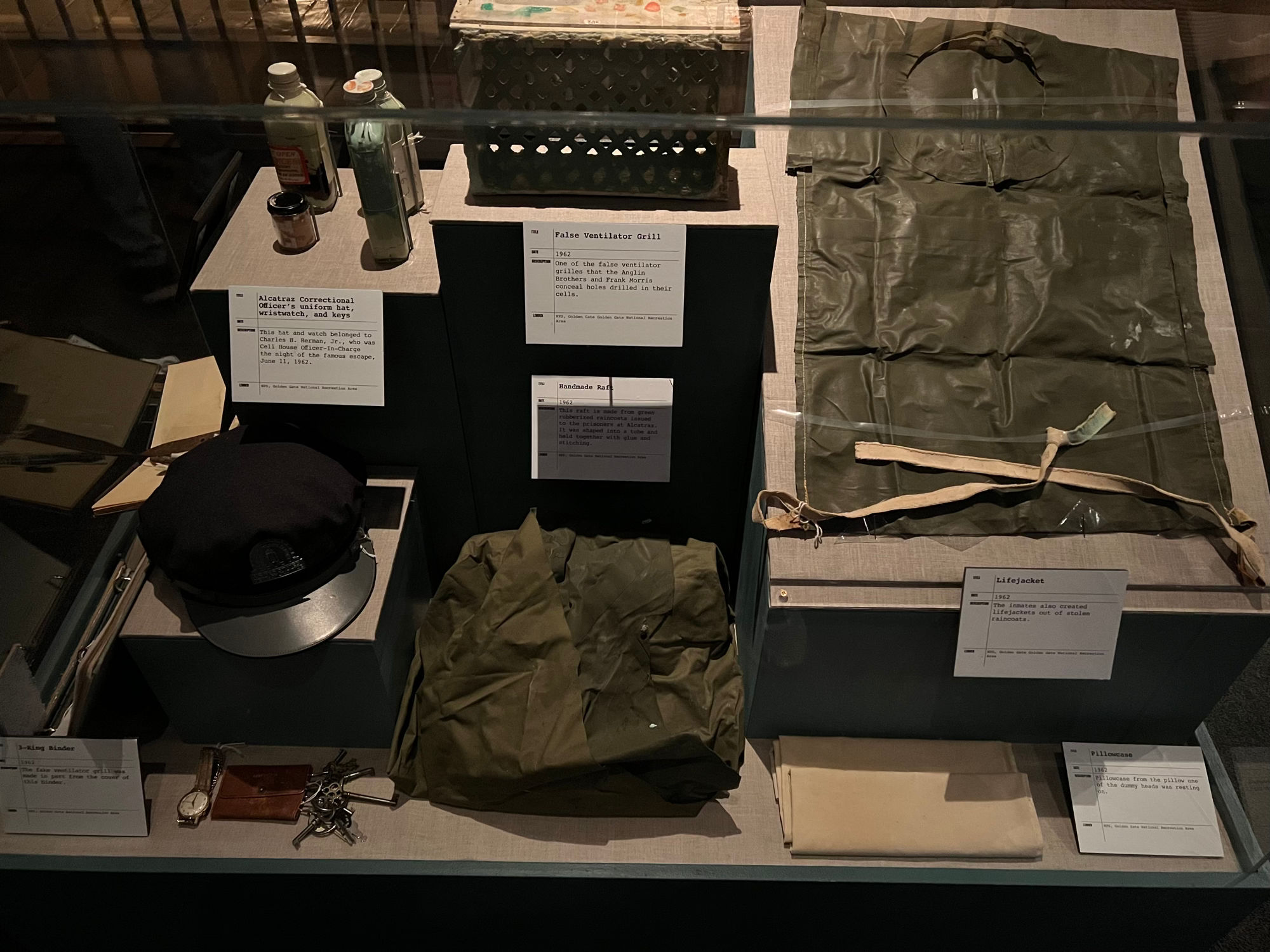
- 3-Ring Binder
The fake ventilator grill was made in part from the cover of this binder. - Alcatraz Correctional Officer's uniform hat, wristwatch, and keys
This hat and watch belonged to Charles H. Herman, Jr., who was Cell House Officer-In-Charge the night of the famous escape, June 11, 1962. - False Ventilator Grill
One of the false ventilator grilles that the Anglin Brothers and Frank Morris conceal holes drilled in their cells. - Handmade Raft
This raft is made from green rubberized raincoats issued to the prisoners at Alcatraz. It was shaped into a tube and held together with glue and stitching. - Lifejacket
the inmates also created lifejackets out of stolen raincoats. - Pillowcase
Pillowcase from the pillow one of the dummy heads was resting on.
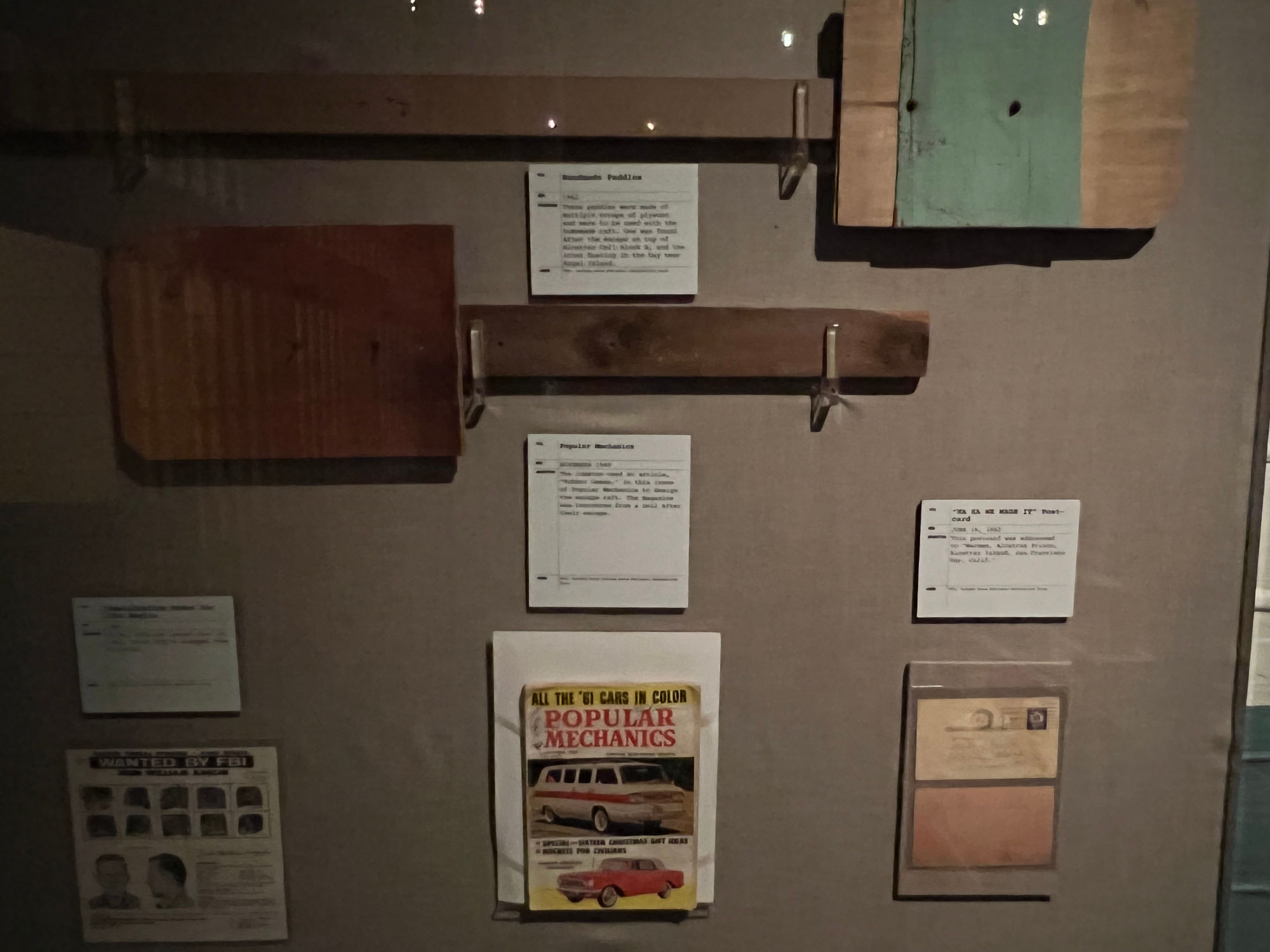
- John Anglin Wanted Poster
- Handmade Plywood Paddles
- November 1960 Popular Mechanics Information on how to build the rubber raft that they used. The magazine was recovered from the cell.
- Ha Ha We Made It postcard Received by the Warden of Alcatraz Prison on June 18, 1962. Hand written words HA HA WE MADE IT Frank John Clarence.
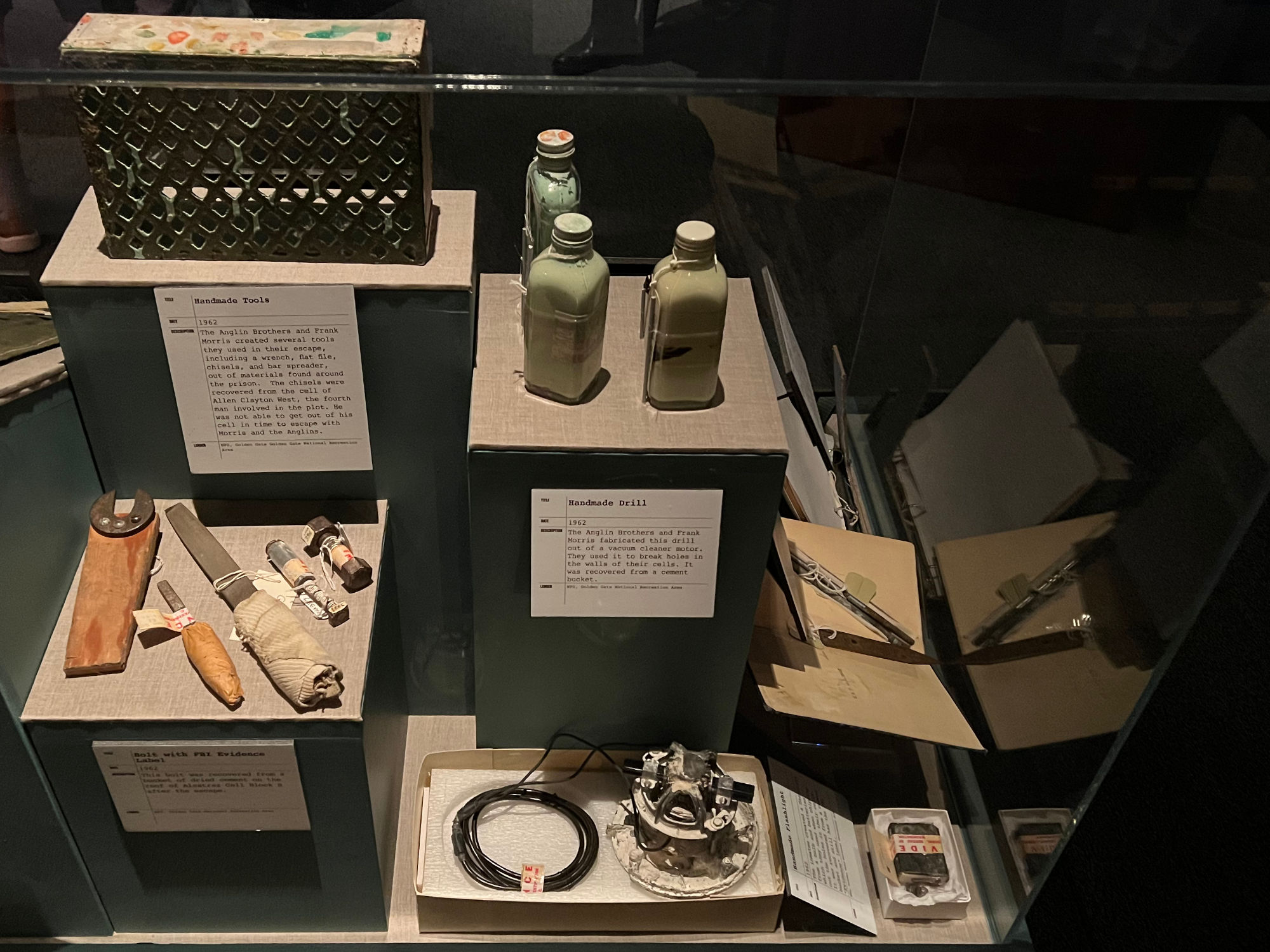
- Handmade Tools
The Anglin Brothers and Frank Morris created several tools they used in their escape, including a wrench, flat file, chisels, and bar spreader, out of materials found around the prison. The chisela were recovered from the cell of Allen Clayton West, the fourth man involved in the plot. He was not able to get out of his cell in time to escape with Morris and the Anglins. - Bolt with FBI Evidence Label
This bolt was recovered from the bucket of dried cement on the roof of Alcatraz Cell Block B after the escape. - Handmade Drill
1962 The Anglin Brothers and Frank Morris fabricated this drill out of a vacuum cleaner motor. They used to break holes in the walls of their cells. It was recovered from a cement bucket. - Handmade Flashlight
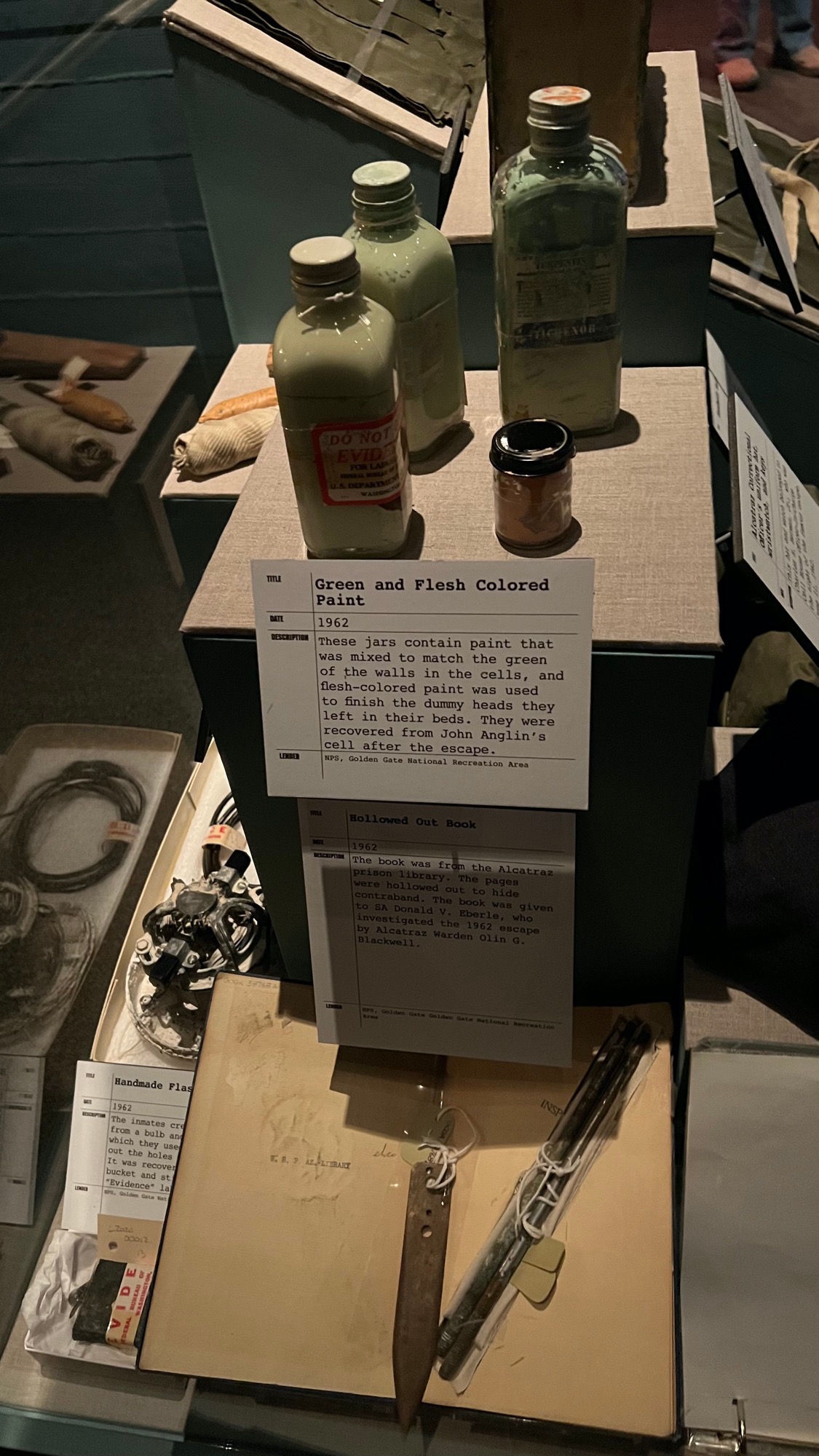
- Green and Flesh Colored Paint
These jars contain paint that was mixed to match the green of the walls in the cells, and flesh-colored paint was used to finish the dummy heads they left in their beds. They were recovered from John Anglin's cell after the escape. - Hollowed Out Book
The book was from the Alcatraz prison library. The pages were hollowed out to hide contraband. The book was given to Special Agent Donald V. Eberle, who investigated the 1962 escape, by Alcatraz Warden Olin G. Blackwell.
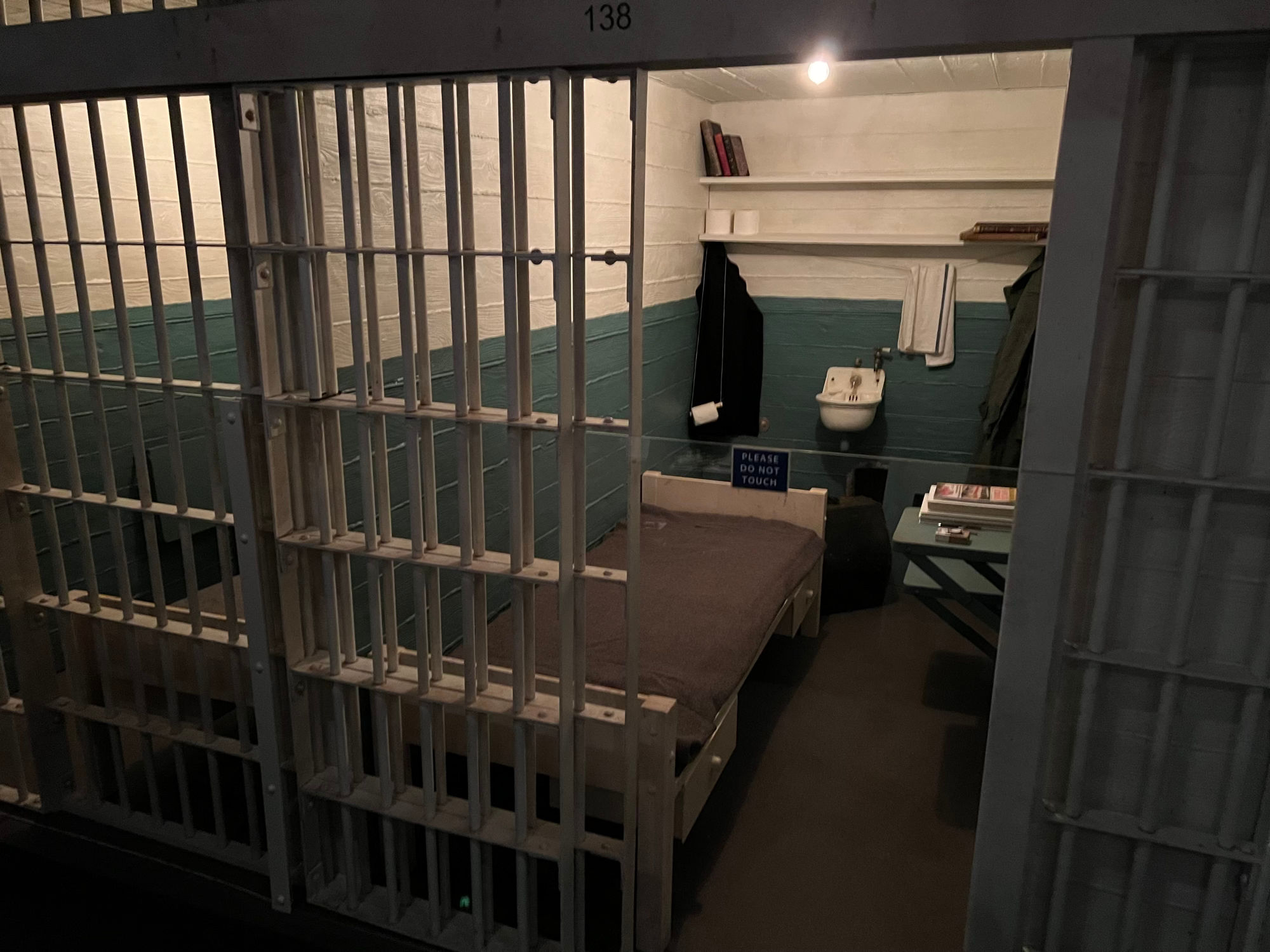
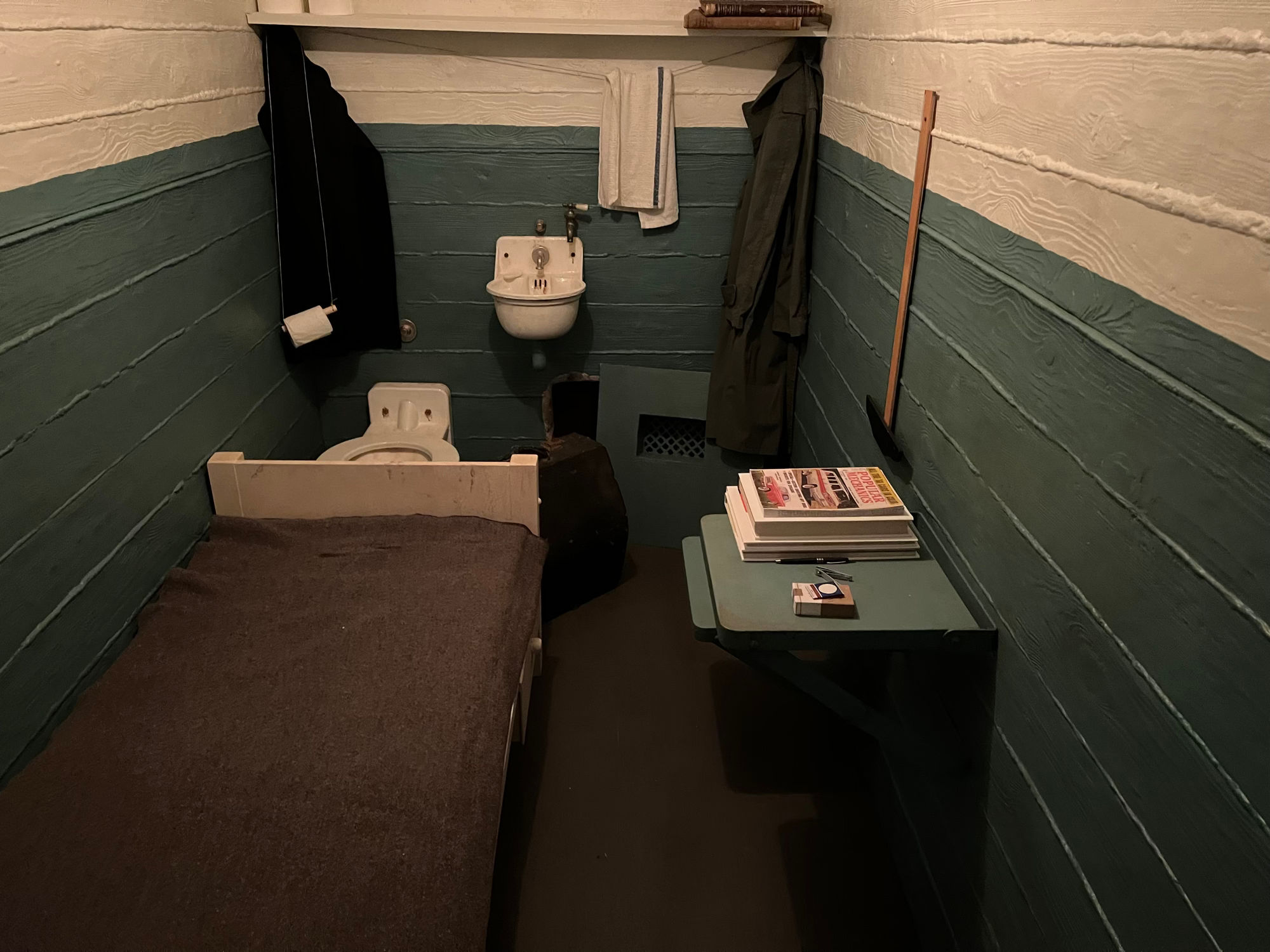
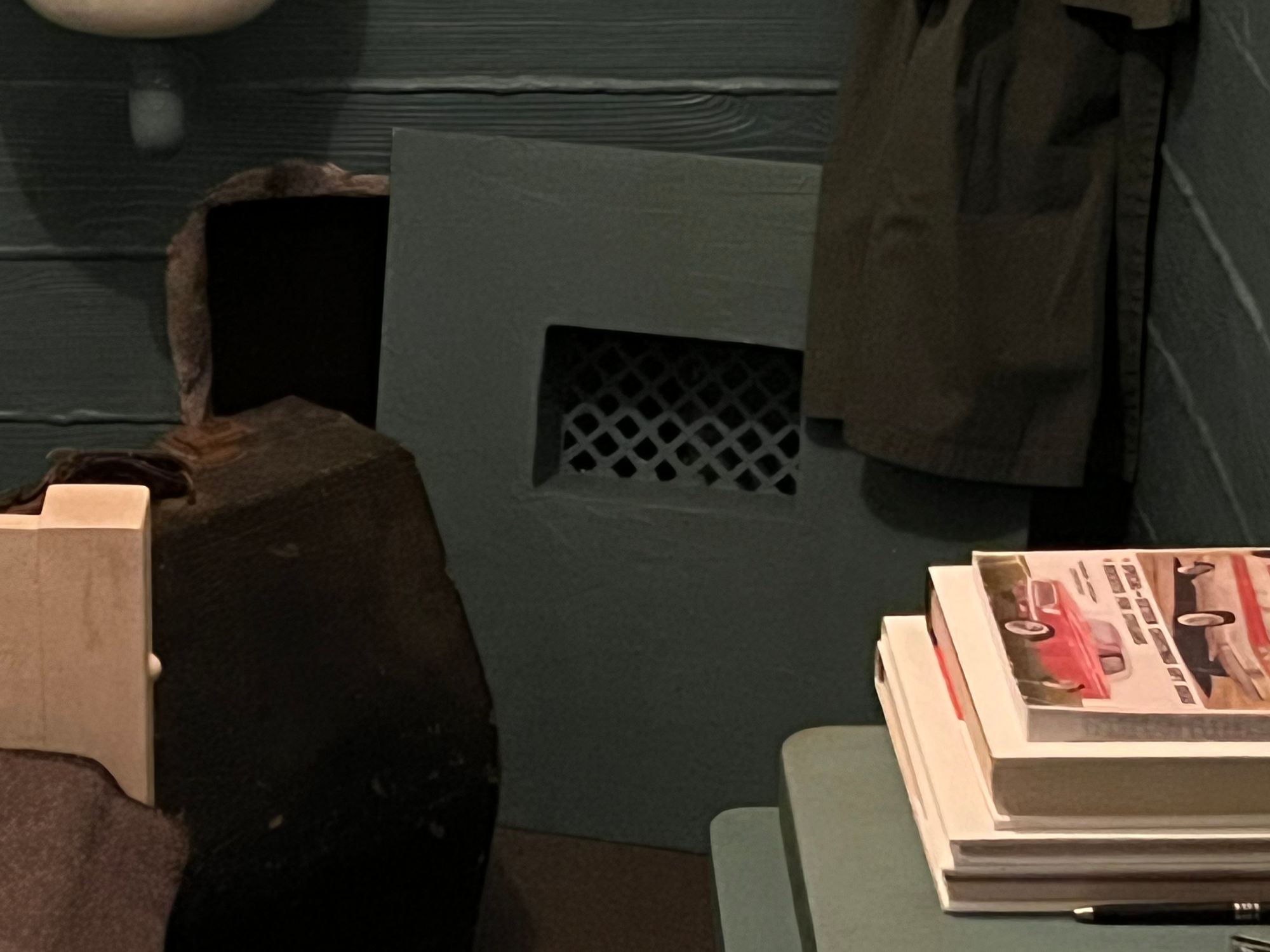
ALCATRAZIn its heyday, it was the ultimate maximum security prison.
Located on a lonely island in the middle of San Francisco Bay, Alcatraz-aka "The Rock"-had held captives since the Civil War. But it was in 1934, the highpoint of a major war on crime, that Alcatraz was re-fortified into the world's most secure prison.Its eventual inmates included dangerous public enemies like Al Capone and George "Machine Gun" Kelly, criminals who had a history of escapes, and the occasional odd character like the infamous "Birdman of Alcatraz."
In the 1930s, Alcatraz was already a forbidding place, surrounded by the cold, rough waters of the Pacific. The redesign included tougher iron bars, a series of strategically positioned guard towers, and strict rules, including a dozen checks a day of the prisoners. Escape seemed near impossible.
Despite the odds, from 1934 until the prison was closed in 1963, 36 men tried 14 separate escapes. Nearly all were caught or didn't survive the attempt.
The fate of three particular inmates, however, remains a mystery to this day. Here is their story.
The Escapees
Frank Morris arrived at Alcatraz in January 1960 after convictions for bank robbery, burglary, and other crimes and repeated attempts to escape various prisons. Later that year, a convict by the name of John Anglin was sent to Alcatraz, followed by his brother Clarence in early 1961. All three knew each other from previous stints in prison.Assigned to adjoining cells, they began hatching a plan to escape. Morris, known for his intelligence, took the lead in the planning. They were aided by another inmate, Allen West.
Missing
On June 12, 1962, the routine early morning bed check turned out to be anything but. Three convicts were not in their cells: John Anglin, his brother Clarence, and Frank Morris.In their beds were cleverly built dummy heads made of plaster, flesh-tone paint, and real human hair that apparently fooled the night guards. The prison went into lock down, and an intensive search began.
Gathering the Clues
We were notified immediately and asked to help.Our office in San Francisco set leads for offices nationwide to check for any records on the missing prisoners and on their previous escape attempts (all three had made them). We also interviewed relatives of the men and compiled all their identification records and asked boat operators in the Bay to be on the lookout for debris.
Within two days, a packet of letters sealed in rubber and related to the men was recovered. Later, some paddle-like pieces of wood and bits of rubber inner tube were found in the water. A homemade life-vest was also discovered washed up on Cronkhite Beach, but extensive searches did not turn up any other items in the area.
Piecing Together the Plan
As the days went by, the FBI, the Coast Guard, Bureau of Prison authorities, and others began to find more evidence and piece together the ingenious escape plan. We were aided by inmate Allen West, who didn't make it out of his cell in time and began providing us with information. Here's what we learned.
- The group had begun laying plans the previous December when one of them came across some old saw blades.
- Using crude tools-including a homemade drill made from the motor of a broken vacuum cleaner-the plotters each loosened the air vents at the back of their cells by painstakingly drilling closely spaced holes around the cover so the entire section of the wall could be removed. Once through, they hid the holes with whatever they could-a suitcase, a piece of cardboard, etc.
- Behind the cells was a common, unguarded utility corridor. They made their way down this corridor and climbed to the roof of their cell block inside the building, where they set up a secret workshop. There, taking turns keeping watch for the guards in the evening before the last count (see the crude "periscope" they constructed for the lookouts), they used a variety of stolen and donated materials to build and hide what they needed to escape. More than 50 raincoats that they stole or gathered were turned into makeshift life preservers and a 6x14 foot rubber raft, the seams carefully stitched together and "vulcanized" by the hot steam pipes in the prison (the idea came from magazines that were found in the prisoners' cells). They also built wooden paddles and converted a musical instrument into a tool to inflate the raft.
- At the same time, they were looking for a way out of the building. The ceiling was a good 30 feet high, but using a network of pipes they climbed up and eventually pried open the ventilator at the top of the shaft. They kept it in place temporarily by fashioning a fake bolt out of soap.
The Escape
On the evening of June 11, they were ready to go.West, though, did not have his ventilator grill completely removed and was left behind.
The three others got into the corridor, gathered their gear, climbed up and out through the ventilator, and got on to the prison roof. Then, they shimmied down the bakery smoke stack at the rear of the cell house, climbed over the fence, and snuck to the northeast shore of the island and launched their raft.
The Mystery Continues
What happened next remains a mystery. Did they make it across the Bay, get to Angel Island, and then cross Raccoon Strait into Marin County as planned? Or did the wind and waves get the better of them?Plenty of people have gone to great lengths to prove that the men could have survived, but the question remains: did they? Our investigation at the time concluded otherwise, for the following reasons:
- Crossing the Bay. Yes, youngsters have made the more than mile-long swim from Alcatraz to Angel Island. But with the strong currents and frigid Bay water, the odds were clearly against these men.
- Three if by land. The plan, according to our prison informant, was to steal clothes and a car once on land. But we never uncovered any thefts like this despite the high-profile nature of the case.
- Family ties. If the escapees had help, we couldn't substantiate it. The families appeared unlikely to even have the financial means to provide any real support.
- Missing in action. For the 17 years we worked on the case, no credible evidence emerged to suggest the men were still alive, either in the U.S. or overseas.
The FBI officially closed its case on December 31, 1979, and turned over responsibility to the U.S. Marshals Service, which continues to investigate in the unlikely event the trio is still alive.
National Park ServiceAlcatraz Island
Golden Gate National Recreation Area, which includes Alcatraz Island, was established by Congress in 1972.Alcatraz Island welcomes over 1.5 million visitors a year.
Alcatraz has a many-layered history: Civil War fortress, military prison, federal prison, bird sanctuary, first lighthouse on the West Coast, and the birthplace of the American Indian Red Power movement: These are just a few of the fascinating stories of the Rock. Alcatraz Island is a designated National Historic Landmark for its significant contribution to the nation's history.
Bureau of Prisons Period - U.S. Penitentiary Alcatraz - 1934-1963
Alcatraz is most famous for the 29 years it operated as a U.S. penitentiary. During this complex period, over 1500 people were incarcerated on the island.United States Penitentiary Alcatraz represents the federal government's response to post-Prohibition, post-Depression America. Both the institution and the men confined within its walls reflect our society during this era.
The collaborative effort of Attorney General Homer Cummings and Director of the Bureau of Prisons, Sanford Bates, produced a high-profile prison that represented the Justice Department's response to fears around public safety and organized crime.
Officials sought to create a new, unique prison for those deemed difficult to incarcerate elsewhere in the federal prison system. A remote site was sought, one that would prohibit constant communication with the outside world by those confined within its walls. Although land in Alaska was being considered, the availability of Alcatraz Island conveniently coincided with the government's perceived need for a high security prison.
Having taken possession of the former Army prison and having circumvented the San Francisco citizens who were concerned at the prospect of a high security federal prison in the near vicinity, the Bureau of Prisons set about selecting a warden who could do the job. A businessman and prison administrator with twelve years of experience in the California Department of Corrections, James A. Johnston was to be that man. Johnston had retired at the time of his appointment by the Department of Justice, and its acceptance resulted in his serving as warden of Alcatraz for the next fourteen years.
Classified as a concentration model, where difficult-to-manage prisoners from other institutions would be concentrated under one roof, Alcatraz served as an experiment. Segregation on this scale had not before been practiced, and only time would indicate its success or failure. Warden Johnston and the second Director of the Bureau of Prisons, James V. Bennett were both leaders in the field of penology. The model they developed on Alcatraz would later serve as a blueprint for the high security federal prison located in Marion, Illinois.
Was the Escape from Alcatraz Successful?
A 2013 letter to the FBI, if real, suggests the Anglin brothers and Frank Morris survived one of the most daring-and dangerous-prison breaks of all time.History.com It was one of the most ingenious prison breaks of all time - if it worked
In 1962, inmates and bank robbers Frank Morris and John and Clarence Anglin vanished from Alcatraz, the federal island penitentiary off the coast of San Francisco. They had used sharpened spoons to bore through the prison walls, left papier-mache dummies in their beds and floated away on a raft made from 50 raincoats.But what happened next has stumped historians for decades. Their bodies were never recovered, leaving many wondering whether they perished in the choppy San Francisco Bay or made it to shore-and freedom.
In the years since nearly six decades of silence from the men led many to conclude that the escape had met a watery end. The FBI closed its case in 1979, concluding that the escapees were unlikely to have survived a treacherous swim of more than a mile of frigid waters to the mainland.
The Letter from John Anglin
In January of 2018, CBS San Francisco published an extract of a letter addressed to the FBI that told an altogether different story-and claimed that the criminals had been at large since the 1960s. "My name is John Anglin," it read. "I escaped from Alcatraz in June 1962 with my brother Clarence and Frank Morris. I'm 83 years old and in bad shape. I have cancer. Yes, we all made it that night but barely!"The letter was sent to the San Francisco Police Department's Richmond station in 2013, the broadcaster reported but had been kept under wraps during a long investigation. An FBI laboratory examined the letter for fingerprints and DNA and analyzed the handwriting within, but the results were inconclusive. "So that means yes, and it means no, so this leaves everything in limbo," security analyst Jeff Harp told CBS.
In the letter, the writer explained that he was the last living member of the trio, with his co-conspirators dying in 2005 and 2008. He offered a deal: If authorities announced on television that he would receive a single one-year jail sentence, in which he could have the medical treatment he needed, "I will write back to let you know exactly where I am. This is no joke…" The FBI did no such thing and instead repressed the letter.
Clues and Sightings of the Escape
Though this is the first time anyone purporting to be one of the men has contacted authorities, it isn't the first piece of evidence that suggests they might have made it out in one piece. Robert Checchi, an officer with the San Francisco police, reported seeing what he described as a "pristine white boat" out in the Bay on the night of the men's disappearance. It had no lights on, but appeared to have someone on board shining a flashlight into the water. Police followed up on the sighting, but couldn't find the owner of this strange boat-or where it went next.More recently, a 2015 HISTORY special showed an alleged photograph of the brothers, taken in Brazil some 13 years after their disappearance. Family members of the men have also reported strange experiences that suggest there may be more to the story than many believe. "It's always been talked about through the family," David Widner, a nephew of John and Clarence Anglin, told CBS. "My grandmother received roses for several years after the escape." If Anglin is still alive today, he would be nearly 90. He has not been heard from since.
Widner expressed dismay that authorities had not contacted the family about his relative's alleged illness. "For him to say he had cancer and was dying, I feel like they should have at least reached out to the family and let them know [the letter] existed," he said.
Federal authorities have been quick to quash any rumors of a successful great escape. In an interview with CBS San Francisco, the U.S. Marshals investigating the case told the broadcaster they considered the lead closed with no merit and a simple hoax from someone hoping to scam and embarrass federal and local authorities. "The Federal Bureau of Prisons say that they drowned once they got off of Alcatraz and their bodies were swept out to the Pacific Ocean-end of story," National Park Service Ranger John Cantwell said.
BBCA mysterious letter has come to light purportedly from one of three inmates who famously escaped Alcatraz in 1962.Someone claiming to be John Anglin wrote to San Francisco police in 2013, but it has only now been made public.
JOHN ANGLIN LETTERMy name is John Anglin, I escape from Alcatraz in June 1962. Yes we all made it that night, but barely!To this day, the three escapees remain on the most wanted list with photos of what they might look like today.
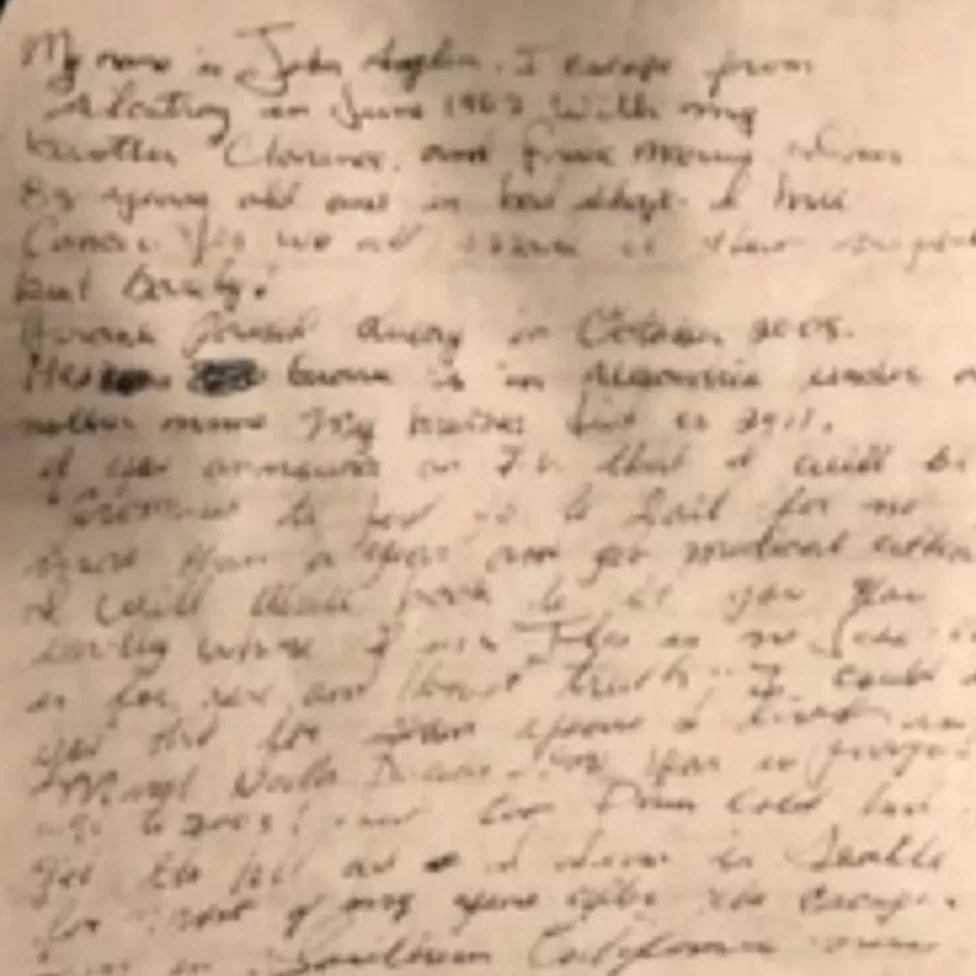
It claims brothers John and Clarence Anglin along with inmate Frank Morris lived into old age after escaping the prison half a century ago.
The author says Clarence Anglin died in 2008 and that Morris died in 2005.
The writer tries to make a deal with authorities, saying:
JOHN ANGLIN LETTERIf you announce on TV that I will be promised to just go to jail for no more than a year and get medical attention I will write back to let you know exactly where I am. I am 83 years old and in bad shape. I have cancer.According to the letter, John Anglin lived in Seattle for most of his life and spent eight years in North Dakota.
At the time the letter was sent he was reportedly living in southern California.
JOHN ANGLIN LETTERThe US Marshals Service
Has been responsible for the case since 1978, submitted the letter to the FBI laboratory for forensic handwriting analysis."Handwriting samples of all three escapees, John Anglin, Clarence Anglin and Frank Morris, were compared to the anonymous letter, and the results were deemed 'inconclusive,'" said a statement from the US Marshals Service.
What do relatives say?
The nephew of John and Clarence Anglin told CBS that his grandmother used to receive roses with John and Clarence's signature on the cards several years after the escape."I really haven't come to a conclusion whether I believe that it's John reaching out or not," nephew David Widner said.
Mr Widner expressed dismay that the letter was not delivered in a timely manner to the family.
"For him to say he had cancer and was dying, I feel like they should have at least reached out to the family and let them know it existed," he said.
WIKIPEDIA Alcatraz Escape
In June 1962, inmates Clarence Anglin, John Anglin, and Frank Morris escaped from Alcatraz Federal Penitentiary, a maximum-security prison located on Alcatraz Island in San Francisco Bay. Late on the night of June 11 or early morning of June 12, the three men tucked papier-mache heads resembling their own likenesses into their beds, broke out of the main prison building via ventilation ducts and an unused utility corridor, and departed the island aboard an improvised inflatable raft to an uncertain fate. A fourth conspirator, Allen West, failed in his escape attempt and remained on the island.Hundreds of leads were pursued by the Federal Bureau of Investigation (FBI) and local law enforcement officials in the ensuing years, but no conclusive evidence has ever surfaced favoring the success or failure of the attempt. Numerous theories of widely varying plausibility have been proposed by authorities, reporters, family members, and amateur enthusiasts. In 1979 the FBI officially concluded, on the basis of circumstantial evidence and a preponderance of expert opinion, that the men drowned in the frigid waters of San Francisco Bay without reaching the mainland. The U.S. Marshals Service case file remains open and active, however, and Morris and the Anglin brothers remain on its wanted list.
New circumstantial and material evidence has continued to surface, stoking new debates on whether the inmates managed to survive.
The Inmates
Frank Morris
Frank Lee Morris (born September 1, 1926) was born in Washington, D.C. Orphaned at age 11, he spent the rest of his childhood in foster homes. He was convicted of his first criminal offense at 13, and by his late teens had been arrested for crimes ranging from narcotics possession to armed robbery. He spent most of his early years in jail serving lunch to prisoners. Later, he was arrested for grand larceny in Miami Beach, car theft, and armed robbery. Morris reportedly ranked in the top 2% of the general population in intelligence, as measured by IQ testing (133). He served time in Florida and Georgia, then escaped from the Louisiana State Penitentiary while serving 10 years for bank robbery. He was recaptured a year later while committing a burglary and sent to Alcatraz on January 20, 1960, as inmate number AZ1441.John and Clarence Anglin
John William (born May 2, 1930) and Clarence (born May 11, 1931) were born into a family of 14 children in Donalsonville, Georgia. Their parents, George Robert Anglin and Rachael Van Miller Anglin, were seasonal farmworkers; in the early 1940s, they moved the family to Ruskin, Florida, 20 miles (32 km) south of Tampa, where the truck farms and tomato fields provided a more reliable source of income. Each June they migrated north as far as Michigan to pick cherries. Clarence and John were reportedly inseparable as youngsters; they became skilled swimmers, and amazed their siblings by swimming in the frigid waters of Lake Michigan as ice still floated on its surface.Clarence was first caught breaking into a service station when he was 14 years old. The brothers began robbing banks and other establishments as a team in the early 1950s, usually targeting businesses that were closed, to ensure that no one got injured. They claimed that they used a weapon only once, during a bank heist – a toy gun. On January 17, 1958, brothers John, Clarence, and Alfred Anglin robbed the Bank of Columbia in Columbia, Alabama. All received 35-year sentences, which they served at Florida State Prison, Leavenworth Federal Penitentiary, and then Atlanta Penitentiary. After repeated attempts to escape from the Atlanta facility, John and Clarence were transferred to Alcatraz. John arrived on October 24, 1960, as inmate AZ1476, and Clarence on January 16, 1961, as inmate AZ1485.
Allen West
Allen West (March 25, 1929 – December 21, 1978) was born in New York City. West was arrested over 20 times throughout his lifetime. He was imprisoned for car theft in 1955, first at Atlanta Penitentiary, then at Florida State Prison. After an escape attempt from the Florida facility, he was transferred to Alcatraz in 1957 at the age of 28 and became inmate AZ1335.The Escape
The four inmates all knew each other from previous incarcerations in Florida and Georgia. When they were assigned adjacent cells in December 1961, they began formulating an escape plan under the leadership of Morris. Over the subsequent six months, they widened the ventilation ducts beneath their sinks using discarded saw blades found on the prison grounds, metal spoons from the mess hall, and an electric drill improvised from the motor of a vacuum cleaner. The men concealed their work with painted cardboard, and masked the noise with Morris's accordion on top of the ambient din of music hour.Once the holes were wide enough to pass through, the men accessed the unguarded utility corridor directly behind their cells' tier and climbed to the vacant top level of the cellblock, where they set up a clandestine workshop. Here, using over fifty raincoats among other stolen and donated materials, they constructed life preservers, based on a design Morris found in the March 1962 issue of Popular Mechanics, with the article, Your Life Preserver - How will it behave if you need it?. Morris found other ideas in magazines; resin to make a lamp shade in the November 1960 issue of Popular Mechanics, and Signposts of Water Safety about channel buoys indicating course and navigation hazards, in the May 21, 1962, issue of Sports Illustrated. They also assembled a six-by-fourteen-foot rubber raft, the seams carefully stitched by hand and sealed with liquid plastic available in the shops, and heat from nearby steam pipes. Paddles were improvised from plywood and screws. Finally, they climbed a ventilation shaft to the roof and removed the rivets holding a large fan in place.
The men concealed their absence while working outside their cells, and after the escape itself, by sculpting dummy heads from a hand-made paper-mache-like mixture of soap, toothpaste, concrete dust, and toilet paper, and giving them a realistic appearance with paint from the maintenance shop and hair from the barbershop floor. With towels and clothing piled under the blankets in their bunks and the dummy heads positioned on the pillows, they appeared to be sleeping.
On the night of June 11, 1962, with all preparations in place, the men initiated their plan. West discovered that the cement he had used to reinforce crumbling concrete around his vent had hardened, narrowing the opening and fixing the grille in place. By the time he managed to remove the grille and re-widen the hole, the others had left without him. He returned to his cell and went to sleep.
From the service corridor, Morris and the Anglins climbed the ventilation shaft to the roof. Guards heard a loud crash as they broke out of the shaft, but nothing further was heard, and the source of the noise was not investigated. Hauling their gear with them, they descended 50 feet (15 m) to the ground by sliding down a kitchen vent pipe, then climbed two 12-foot (3.7 m) barbed-wire perimeter fences. At the northeast shoreline, near the power plant-a blind spot in the prison's network of searchlights and gun towers-they inflated their raft with a concertina stolen from another inmate and modified to serve as a bellows. At some time after 10:00 p.m., investigators estimated, they boarded the raft, launched it and departed toward their objective, Angel Island, two miles to the north.
The escape was not discovered until the morning of June 12 due to the successful dummy head ruse.
The Search
Multiple military and law-enforcement agencies conducted an extensive air, sea, and land search over the next 10 days. On June 14, a Coast Guard cutter picked up a paddle floating about 200 yards (180 m) off the southern shore of Angel Island. On the same day and in the same general location, workers on another boat found a wallet wrapped in plastic complete with names, addresses, and photos of the Anglins' friends and relatives. On June 21, shreds of raincoat material, believed to be remnants of the raft, were found on a beach not far from the Golden Gate Bridge. The following day, a prison boat picked up a deflated life jacket made from the same material 50 yards (46 m) off Alcatraz Island. According to the final FBI report, no other physical evidence was found.










